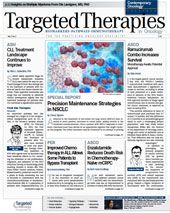Minimal Residual Disease (MRD) Marches to Front Line of Myeloma Research
More than two dozen abstracts at the December 2013 meeting of the American Society of Hematology (ASH) focused on the detection, measurement, or monitoring of MRD in patients with multiple myeloma.
Brian G. M. Durie, MD

Brian G. M. Durie, MD
More than two dozen abstracts at the December 2013 meeting of the American Society of Hematology (ASH) focused on the detection, measurement, or monitoring of minimal residual disease (MRD) in patients with multiple myeloma (MM). This emphasis is “very exciting,” according to Brian G. M. Durie, MD, founder and chair of the International Myeloma Foundation (IMF) and Hematologist/Oncologist at Cedars-Sinai Medical Center in Los Angeles, California. According to Durie the focus on MRD reflects real progress in what the IMF recently declared as the goal of its Black Swan Research Initiative (BSRI): MRD-Zero.1
MRD-Zero will be achieved when tools are available to physicians to successfully determine when patients arrive at, and are able to sustain, the status of MRD. One study reported at ASH showed that it can be done. Ola Landgren, MD, PhD, and colleagues showed in a small pilot study that 11 of 12 patients with high-risk smoldering MM (HR-SSM) achieved and sustained MRD-Zero.2
Several other abstracts from ASH examined the expanded possibilities in MRD testing and monitoring with the use of alternative sophisticated models.
In a Spanish study, researchers undertook a first-time characterization of the MRD clone at the biological level, as what they described as a “unique model for understanding chemoresistance.” This is important work, Durie commented, because there is a need to better understand the nature of resistant subclones in order to achieve MRD-Zero.3
Black Swan Research Initiative
There are no black swansuntil there is a black swan.
There is no cure for multiple myeloma. Until there is a cure. Thus, the Black Swan Research Initiative (BSRI) of the International Myeloma Foundation is well-named for what is described as a breakthrough approach to finding a cure for myeloma.
The BSRI is unique as an “actual research project aimed at finding a functional cure for myeloma, not an open-access platform to support external research,” explained Brian G. M. Durie, MD, in one of his regular online postings, “Dr. Durie’s Blog.”1
“A core tenet of BSRI is that many patients might be cured [already] and don’t know it because previously we have lacked the sophisticated tests necessary to determine that zero minimal residual disease (MRD-Zero) has been achieved.”
The most recent ASH meeting featured testing methods for MRD with great near-term potential.
Reference
“Using the latest procedures involving flow cytometry and full DNA sequencing, we will be able to detect down to less than 1 cell per million of myeloma. Thus, we can identify who has been cured, and what combinations of therapies led to that cure.”
- Black Swan Research Initiative’s distinctly different pathway to a cure.http://myeloma.org/MtEntryPage. action?source=/imf_blogs/myeloma_voices/2013/09/black-swan-research-initiativesdistinctively- different-pathway-to-a-cure.html
Complete eradication of all subclones in MM is required to prolong patient survival. Members of the same group from the Universidad de Salamanca, Spain, conducted a sophisticated analysis of subclones with different genetic profiles, clonogenic profiles, and differing drug sensitivities. They found that distinct phenotypic subclones translate into different cytogenetic profiles and clonogenic potential. As the balance between different subclones changes over the course of treatment, so does the extent of specific cytogenetic abnormalities, as well as patient risk. “Careful monitoring of specific subclones may have implications toward an adapted therapy to overcome chemoresistant cells,” the investigators concluded.4
Regarding the clinical implications of this work, Durie said that an understanding of subclones, which persist or emerge despite current novel therapy, “is key to developing more successful treatment and achieving MRD-Zero.”
A number of abstracts at the ASH meeting compared molecular testing and flow cytometry to assess MRD.
One was a “deep sequencing approach” to an analysis of bone marrow samples from 133 patients who were treated similarly within the Spanish Myeloma Group trials.5The investigators compared the prognostic value of traditional response criteria to assess MRD with a sequencing-based platform (LymphoSIGHT), multiparameter flow cytometry (MFC), and allele-specific oligonucleotide polymerase chain reaction (ASO-PCR) of Ig genes. Their findings established a near equivalence between the MRD studies, at 91%, and the flow cytometry, at 96%. The investigators also found a high correlation between MRD levels by sequencing, by ASO-PCR, and by MFC. Based on these results, “MRD assessment by sequencing is a useful method for patient risk stratification and can be used to determine molecular complete response (CR) in MM,” the group concluded.
A group from the National Cancer Institute, led by Landgren, compared serum heavy-light chains (HLC) with free light-chains (FLC) as predictors of early CR in newly diagnosed patients with myeloma who were treated with carfilzomib, lenalidomide, and dexamethasone in an ongoing, prospective, clinical trial for patients with MM and HR-SMM.6
Early monitoring (after 2 cycles) of HLC patterns, the group found, was an independent predictor of rapid response.
References
- The International Myeloma Foundation. The International Myeloma Foundation launches the Black Swan Research Initiative to develop the very first definitive cure for multiple myeloma.http://myeloma. org/BSRI/IMF_BlackSwanLaunch_031113_F3.pdf
- Landgren O, Mailankody S, Kwok M, et al. Clinical and correlative pilot study of carfilzomab, lenalidomide, and dexamethasone followed by lenalidomide extended dosing (CRdR) in high-risk smoldering multiple myeloma. American Society of Hematology, 2013. Abstract 1939.
- Paiva B, Corchete LA, Gutierrez N, et al. Phenotypic and genomic analysis of multiple myeloma (MM): minimal residual disease (MRD) clonal plasma cells. American Society of Hematology, 2013. Abstract 402.
- Paino T, Paiva B, Sayagues JM, et al. Phenotypic identification of subclones in multiple myeloma with different genomic profile, clonogenic potential and drug sensitivity. American Society of Hematology, 2013. Abstract 531.
- Martinez-Lopez J, Lahuerta JJ, Pepin F, et al. Prognostic value of deep sequencing approach for minimal residual disease (MRD) detection in multiple myeloma patients. American Society of Hematology, 2013. Abstract 1848.
- Bhutani M, Costello R, Korde N, et al. Serum heavy-light chains (HLC) and free light chains (FLC) as predictors for early CR in newly diagnosed myeloma patients treated with carfilzomib, lenalidomide, and dexamethasone (CRd). American Society of Hematology, 2013. Abstract 762.









